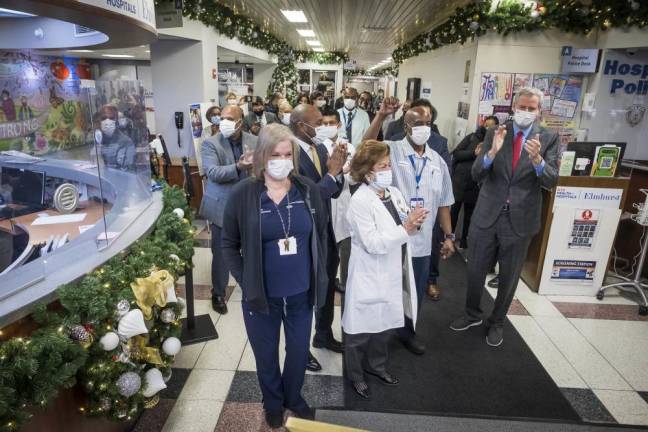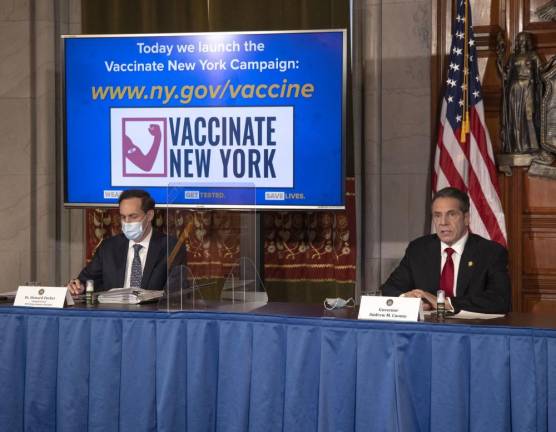Hope is not just around the corner. Public officials should make that clearer, says Professor Nina Schwalbe, before expectations for an early end to the pandemic grow so prevalent that what follows is frustration, disappointment and, ultimately, mistrust of the new vaccines.
“There is currently widespread confusion about whether the aim of the roll-out is to prioritize and protect the individual being vaccinated, or to build up immunity in the larger community to slow the spread of the virus — or both,” Schwalbe wrote this week in The BMJ, the journal of the British Medical Association.
Schwalbe, an expert on the relationship between populations and health, teaches at Columbia’s Mailman School of Public Health and has been deeply involved in global vaccine efforts at UNICEF and GAVI, the alliance that raises billions of dollars from governments and foundations to supply vaccines to poorer countries.
The challenge for public officials in the coronavirus crisis is to communicate both more and more precisely, Schwalbe says.
Examining the statements this past week of Governor Andrew Cuomo and Mayor Bill de Blasio, it seems fair to say they have been unable to resist what might be described as the Ronald Reagan school of Morning-in-America sunshine messaging. Or at least, glass-half- full communication.
“This is now a footrace between the vaccine and COVID,” Cuomo said Friday, “and as we slow the spread we also have to accelerate vaccine distribution at the same time. The faster we vaccinate people, the quicker new COVID cases go down.”
De Blasio, in his regular appearance on WNYC radio, was asked by two separate callers, a restaurateur and a high school teacher, about the damage and pain of lockdowns.
“This situation will change in January and February,” the mayor assured the teacher, “there was no question in my mind. We will turn around the current spread and the vaccine’s going to play a profound role. We’ll go into the spring and a different situation that will feel better and September will be night and day compared to what we’re dealing with now. So, please hang on.”
To the restaurant owner, he said: “We need to do this for a brief period of time and now we have the vaccine ... So, it is not a big, open-ended thing where you have to keep suffering. It is let’s stop this infection increase and get the vaccine out there and then we take the big turn to the post-COVID era. I want to see you guys get back with indoor dining as quickly as possible.”
Two Premises
There seem to be two premises baked into the way Cuomo and de Blasio are presenting the situation, neither quite accurate.
The first is that the vaccine will prevent infected people from passing on the virus and the other is that as this happens “herd immunity” will develop incrementally as more people are vaccinated.
Do the vaccines block the spread?
“The issue is that the current vaccines have not been tested vis a vis reducing transmission,” Schwalbe says. “The endpoint of the study and basis for approval, was prevention of disease.”
This question is being studied now and there have been hopeful tests with infected animals.
“We don’t yet know the effectiveness at the population level, that is, does it prevent an individual from transmitting,” Schwalbe adds. “One really important point: ‘We don’t know’ does not mean that it will not – it literally means, “we don’t know yet.”
But even if the vaccines do prevent passing on the virus there is the high hill of herd immunity. Dr. Anthony Fauci, the federal government’s leading expert on infectious diseases, says that 75% of the public must be immunized to create herd immunity, the phenomenon where an infectious disease stops spreading because it can’t find enough new hosts.
Of course we won’t know for sure if 75 percent is even correct until we get there. But it is misleading to say the spread will slow as the first waves of vaccine are administered. So, for example, the Governor announced that all residents and staff of 618 long term care facilities for the elderly will be offered their first dose of the vaccine by the end of the year.
This should dramatically decrease deaths, since the death rate among the elderly is so much higher than among the young.
Deaths Among Young Adults
But protecting seniors in nursing homes does little to stop the disease from spreading elsewhere, say among younger adults. This is more than a pedantic public health point. President-elect Joseph Biden’s pick to be head of the Centers for Disease Control, Dr. Rochelle P. Walensky, published an article with colleagues this week in The Journal of the American Medical Association pointing out that deaths from COVID-19 among young adults were frighteningly high, rivaling deaths from drug overdoses as the leading cause of death in that age group. The death rate only looks low in comparison to older people.
So mixed messaging isn’t just confusing, it can be dangerous.
Schwalbe points out that 75 percent immunization is a long way off. For one thing, she notes, there is currently no vaccine approved for those under 18, about 20% of the population.
Which means that herd immunity would require virtually every adult to be vaccinated, or survive infection, a major challenge given vaccine resistance as well as the blank page in our knowledge of how long immunity will last.
Right now the strategy clearly is to protect the most vulnerable even if some of the public pronouncements imply more.
Raising expectations can undermine support for other needed actions, starting with basics like mask wearing. Recognizing that herd immunity is still a long way off invites a renewed focus on basic public health efforts that can reduce COVID-19 deaths by reducing the prevalence of treatable illnesses, the so-called “comorbidities” that include diabetes, high blood pressure and heart disease.
In this appeal for improving the basic public health infrastructure, Schwalbe is joined by organizations as different as the Partnership for New York City, the business alliance, to Resolve to Save Lives, a global public health NGO.
The Partnership said last August that a strengthened network of local public health was essential to the city’s economic recovery.
“It’s literally now or never to fix public health at local, city, state, national, global levels,” Dr. Tom Frieden, President of Resolve to Save lives and former head of the CDC wrote Friday. “If this isn’t a teachable moment, there will never be one. Vaccination may end this pandemic but not the risk of pandemics. Money, technical and operational capacity are all needed.”
“We don’t yet know the effectiveness at the population level, that is, does it prevent an individual from transmitting ... ‘We don’t know’ does not mean that it will not – it literally means, “we don’t know yet.” Nina Schwalbe of Columbia’s Mailman School of Public Health

